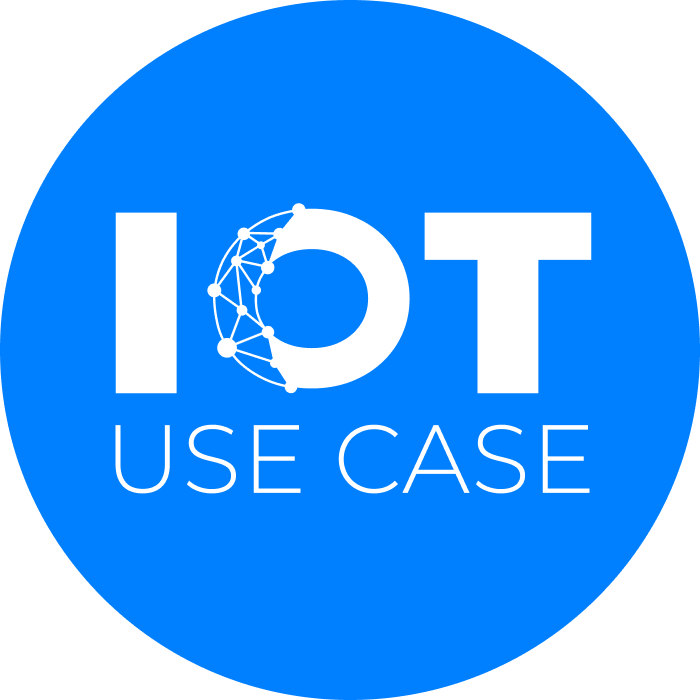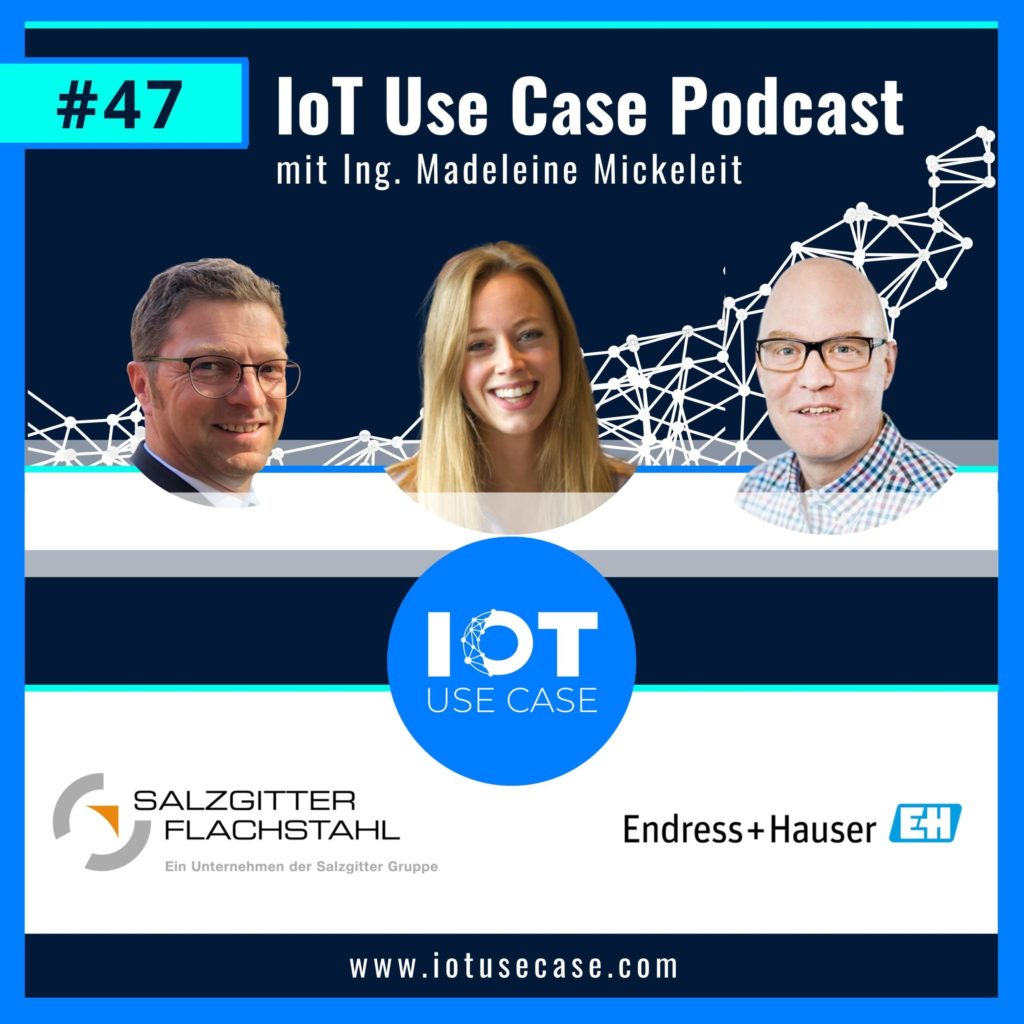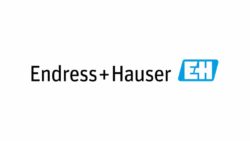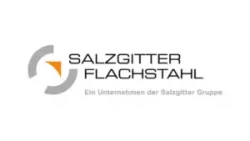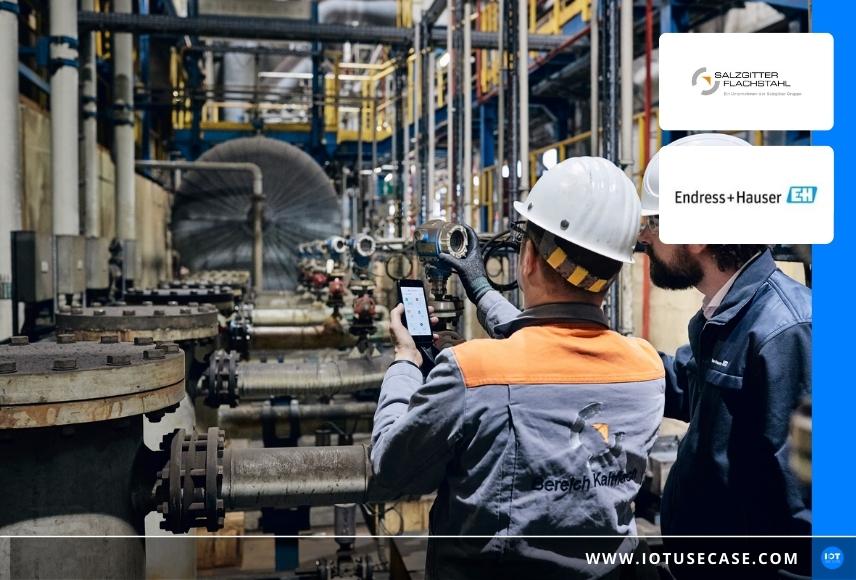A plant availability of more than 85% in steel production? Optimized process and condition monitoring thanks to digital infrastructure + IoT make it possible! This is what the guests of the 47th episode of the IIoT Use Case Podcast report on: Endress+Hauser with Hans Huber (General Manager Industrial Internet Of Things, Endress+Hauser) and its customer Salzgitter Flachstahl, represented by the Chief Engineer Jan-Marten Claus.
Podcast episode summary
This episode of the IIoT Use Case Podcast is all about IoT networking of already highly automated steel production. Endress+Hauser, a company based in industrial measurement instrumentation, presents its IIoT pilot project with crude steel producer Salzgitter Flachstahl. One of the key takeaways: Only with digital infrastructure and corresponding digital tools is it possible to meet plant availability requirements in such a complex, highly automated area.
The focus on two different types of data makes the customer requirements of this use case clear: From the point of view of the pure automation process, measurement data are elementarily important. In the past, these could already be viewed via a dashboard, the HMI (Human Machine Interface). From the perspective of the maintenance engineer and availability, the focus is on the status data of the sensors and actuators. It is intended to provide a comprehensive overview of measurement instrumentation: How is my engine doing, how is my sensor doing, how is my measurement instrumentation doing? Without IoT, this previously required going to the machine. Salzgitter Flachstahl says: Further data was already there due to the fieldbus system already in place, but it was not used. Today, there is Internet connectivity all the way to the fieldbus and transfers the data to the cloud. This requirement has been a focus of the two companies’ cooperation to date. Initially, there were security concerns, coupled with the request to retain control over one’s own data. The architecture of the Endress+Hauser IoT solution addressed these customer requirements and built the solution to be certified to the international ISO 27001 standard, thus meeting globally recognized IT security standards. In addition, there is a read-only channel that allows read-only access without primarily interfering with the control.
In the podcast episode, this IoT implementation process is described using Kontibeize II – a plant that produces about 2,500 tons of steel per work shift and is one of the centerpieces of steel production. The podcast episode also explains in more detail what other advantages are associated with process and condition monitoring for Salzgitter Flachstahl, and how this use case can be transferred to other use cases.
Podcast interview
Welcome to the IIoT Use Case Podcast – the channel where the latest IoT projects from users and implementation partners are presented on a weekly basis. I’m your host Madeleine Mickeleit and in today’s Use Case I’m talking to Endress+Hauser, the expert in process automation and of course the topic of the Industrial Internet of Things as well as the customer Salzgitter Flachstahl. I’m particularly pleased about this, by the way, because Lower Saxony is my home state, and steel production with its supply chain naturally also holds enormous potential for the industrial Internet of Things.
In this episode you can find out how steel production and the steel industry are positioning themselves for the future and what exactly the IIot pilot project with Salzgitter Flachstahl looks like. As always, the use case, i.e. the project description, can be read at iotusecase.com. Then I would say, let’s start directly into the episode and I would like to welcome Hans-Jürgen Huber from Endress+Hauser and Jan-Marten Claus from Salzgitter Flachstahl.
Let’s start with a short round of introductions: Hans, I’m looking in your direction. Could you briefly say something about you and your company and perhaps give a brief outlook on how you are heading in the direction of IoT or the Industrial Internet of Things in the future?
Hans
Yes, very much so. My name is Hans Huber. I have been with Endress+Hauser for 4 ½ years now and am helping to build up the industrial IoT division. Endress+Hauser is a company that deals with industrial measurement instrumentation. We are a leading supplier there in industries such as steel production, but also in the food industry and in the chemical and pharmaceutical sectors, where we have a comprehensive portfolio of industrial measurement instrumentation. And for several years now, we have of course been asking ourselves what digitization and IoT mean for the Endress+Hauser Group, and we have developed a range of products and services that allow us to get much more involved in the area of information management and information-based services, and we have developed a kind of ecosystem of various services and products around our Netilion product.
Very nice. I would also ask about this in more detail right away. Now you brought your customer today. Jan, I would like to welcome you once again to the group and say, would you like to join the round of introductions and say one or two things about yourself and what exactly you do at Salzgitter Flachstahl in terms of your core business?
Jan
My name is Jan-Marten Claus. I come from beautiful Hanover and live here with my family and my three children. From my history, I studied electrical and automation engineering in Hanover and then initially went into the automotive industry. After eight years in the automotive industry with various stays abroad, it was all too boring for me and I moved to beautiful Salzgitter, to the steel industry. So a complete change I made there professionally. At the former Salzgitter AG, I was then initially responsible for various new construction and modernization projects and, among other things, also built the plant we are about to talk about in Mitte. Since 2013, I have been responsible as an operating engineer in the cold flat area for electrical and automation technology and the complete energy supply for Kontibeize II and regeneration.
Perfect, thank you very much. That’s where I’d like to chime in now. You’ve just said it’s about a specific plant, the pickle. Perhaps to situate the topic on site a bit more: steel production – I mean, one or the other has already been to the plant – but for those who are perhaps not that into the details, what does it look like on site, what kind of people work there, with what tasks, what do the processes look like? Can you tell us a little about how steel production actually works?
Jan
Yes, very much so. Salzgitter Flachstahl, which is the company where I work, is the largest steel subsidiary of the Salzgitter Group, Salzgitter AG. With around 5,500 employees, we produced 4 ½ million tons of crude steel in 2019, for example, and generated sales of just under 3 billion euros. We are an integrated steel mill. We produce various products that are then sent to the customer, including pickled or unpickled hot-rolled wide strip, strip steel, strip plate, cold-rolled sheet and various surface-finished products, i.e. galvanized, anodized or coated. So, the products that leave our company are referred to as flat products or flat steel. The dimensions we sell range in thickness from 0.5 to 25 mm, i.e. from thin to relatively thick, with a width of up to 2,000 mm. The customers we have are, among others, vehicle manufacturers and their suppliers, household appliance manufacturers, so-called white goods, i.e. the washing machine from Miele, the shell that is around it, is already finished painted with us and has already gone out as a coil, then tube and large tube manufacturers cold rollers, construction industry etc.
Okay. Now you had just talked about the plant of the pickling. Where exactly is this pickling used in the steel production process? Just to get an idea?
Jan
It is actually a small plant in terms of dimensions, but it is the core plant in our country where almost all the material that goes out passes through. Now back again. We are an integrated steel mill, which means that we receive coal, iron ore, a few aggregates and then the whole thing is processed, first in the blast furnace and the sinter plant. The sintering plant produces the material for the blast furnace. In the blast furnace, all this is melted into crude steel. This crude steel is then alloyed, refined, processed and cast into slabs at the steel mill. These slabs are then rolled out in the hot rolling mill, where our flat products are produced. The flat products then go either directly from the hot rolling mill out to the customer or after various further processing, e.g. in Kontibeize II, in the plant we will talk about in a moment. There, the hot rolled product, the hot strips are pickled, i.e. cleaned, so that they can then be sold for further processing without surface damage or we process them further internally. And then we have various other processes: we roll it out into various grades that the customer wants, various machining is done, machined in width, machined in length, so that you can also buy sheets from us. It is refined, galvanized, anodized or even coated.
Yes, very nice, my heart goes out to mechanical engineering. I originally studied mechanical engineering and it’s nice to hear something from the world of practice again, including this area. Very exciting. Did you just want to add something?
Jan
I was actually at the end. Except that it’s definitely a challenge for mechanical engineers.
Exactly, challenge is actually also a bit of a keyword where I now want to follow up once again. Perhaps to look at the whole issue from 3 steps back again: Your core business is exactly what you have just described. Now, somewhere in this area, the topic is digitization. I would be interested to know what are some of the challenges you face in your day-to-day work or potentials that are also somewhat related to this digitization strategy of yours? What are the challenges here and why did you go this way in the first place?
Jan
As you say, your mechanical engineering heart laughs when you think of a smelter or a steel mill and when you see it from the outside, you also think, oh my God what is all that. A steel mill is a relatively harsh environment, but you have to remember that, for example, the Kontibeize II is one of the bottlenecks of the plant, where almost everything that we then deliver to the customer passes through. The Kontibeize II is operated in a 24:7 mode, i.e. we operate 7 days a week, 24 hours a day and have a short, absolutely planned repair shutdown every 2 weeks. Now the requirement is: Kontibeize II produces about 2,500 tons of steel per shift. In other words, more than 100 coils pass through it, which are unwound at the front, processed, cleaned, and exit again at the back, all in a fully automated process. The people who work for us either have maintenance-related tasks or they essentially have monitoring tasks. If the automation then breaks down somewhere, because the product is naturally also a bit rougher, then people have to intervene. In other words, we have a very, very high level of automation. This also means, of course, that this high degree of automation and this high performance that we drive, that we have a very high requirement for availability. This in turn means that everything has to work well, that we have to be pretty digital, and that the measurement instrumentation also has to work smoothly. With my maintenance team, we are only dependent on various digital aids for the Kontibeize II and the associated ancillary systems in order to find the causes quickly and efficiently, e.g. during troubleshooting, and to be able to rectify them. So only with digital infrastructure and corresponding digital tools is it possible to operate this plant in such a complex, highly automated area with an availability – the target for us is greater than 85%. Considering how rough the environment looks and just the rough mechanical engineering, what kind of motor ratings we’re talking about, we’re talking 2 x 25 mega watt feed load on 30 KV. This is also a challenge for maintenance and digitization.
Yes, perfectly. The name was Kontibeize II? Does this have anything to do with Continental?
Jan
No, that has nothing to do with it, but that we have a continuous process. There are two different stains: there is either a push stain or a continuous pickling line. In push stain, each strip is pushed in individually and moved through the line, and continuous pickling line is where we weld the coils together at the inlet, so the strips are unwound, welded together in a very large complex welding line, and then an endless belt moves continuously through the process. And that is where the name Kontibeize comes from.
Now I also have it pictorially in my mind as it is written. Today we want to focus a bit on this plant and the processes around it. Now, to talk about the IIoT solution right away, I would like to talk a little bit about the data. You had said now, it’s about availability somewhere, it’s about establishing causes. You have the maintainers on site, you have to ensure monitoring. What is some other data or even information here that is relevant to you from this stain? Do you have any insight into the possible data that is recorded there?
Jan
Yes, of course, it depends on which data and from which angle I look at the whole thing. If I now look at this from the pure automation process, i.e. the plant must run, then various measurement data are elementarily important for me. This measurement data works in the automation, the automation evaluates this measurement data and then appropriate actions take place in the process. We go slower, we go faster, we give more steam, we give more temperature and things like that. On the other hand, if I have the perspective of availability, i.e. the maintenance manager, then of course I need the status data of my sensors and actuators. I need to know how my engine is doing now, how my sensor is doing, how my measurement technology is doing.
Now let’s ask in the direction of IoT, if you take the buzzword now: But that’s data, you probably already have it in the system. Now I don’t know if it’s an MES system (Manufacturing Execution System), but that data is probably available as it is, right?
Jan
I’ll say, in principle, they are available. They are potentially somewhere and were not actually called up until the start of our IoT project with Endress+Hauser. Let me explain that briefly: We have a very high automation structure. We are talking here about about 13 automation devices, i.e. PLCs or also fast control systems, various small PLCs that are added, and all of them are completely networked, i.e. we have a very extensive field bus, with about 2,500 nodes on it, which are completely networked via the Profibus DP. In other more modern areas we have the Profinet running and so we also have our measurement technology completely networked via the Profibus PA, i.e. we call up all our measured values via it so far.
Can you again, very briefly, for those who are not familiar with automation, give some context to Profibus as a term?
Jan
The Profibus is a field bus. So on field level I collect all signals via this bus. For people who don’t know similar terms, they may know the Profinet or a Devicenet or similar. So it is a pure field bus, where I collect all the signals from the large plant and the automation devices, so in this case PLC further processed.
In other words, an infrastructure that ensures that data is available or that it can be recorded at all, the ultimate connectivity.
Jan
Right. But then it’s built in such a way that they really only look into the field and are not visible at all to the outside world, i.e. via the Internet, for example, or via other steel-mill wide networking. So completely sealed a pure field bus.
Yes, that would be the security issue, which is probably also important. Perhaps to stay with the data once again. Now with your IIoT project – what data are you interested in? Is that primarily availability data or condition data, or is that the data you need to determine specific root causes? You had now also talked about temperature pressure data. What data are you recording there with the IIoT in mind?
Jan
The measurement data itself, we have it in the automation, we can see it in our HMI, we already have it initialized everywhere. Now it’s a matter of how is our meter doing. Right now, or so far, it’s been that we’ve actually had to go to the meter to see how it’s doing. So we had to look at the display and on the display was then the corresponding state or error code. Now, however, this data is potentially already present on the Profibus, i.e. on the field bus, which means that there must now be a way for us to actually retrieve this data. That’s where IoT comes into play, that we retrieve this data, i.e. primarily the status data of the measurement technology. Of course, the whole thing now means that we have a connection somewhere from the Internet down to the fieldbus, which is then of course protected accordingly. And here at Salzgitter Flachstahl, we have a corresponding process for assessing data security, a so-called protection needs analysis. So we look at what data do we have, which way does that data flow, and where does that data go? And accordingly, it is then determined what protection needs we have, so what do we need to do? So proxy servers, firewalls or similar.
This brings us to the topic of data security: If I imagine that I have to bring everything together from the control level via the edge, i.e. somewhere the data pre-processing, which is already running on the machine anyway, plus the cloud, plus the most diverse systems, then security is an incredibly important topic. Hans, now the question to you, how do you approach the issue? Is that how you see it? Or what is the relevance from your side?
Hans
Yes, absolutely. The issue is very relevant. In principle, all our customers are involved in critical production processes, and the primary task is to make the production process safe in the first place. The topic of safety, security, also for the production process as such is of course in the foreground to avoid accidents or other incidents. And in the second step, we also need to optimize product quality, so this is an issue that we really considered to be extremely important from the outset in the architecture of our IoT solution, and we have actually taken various measures to address it. On the one hand, we are also ISO 27001 certified with this solution, which means that we have addressed a whole range of IT security points and also reflected them in processes, so that we can carry them out regularly and also achieve this security in a reproducible manner. Then, of course, the other issue is that we have established this so-called second channel there, which is actually a pure read channel, so that we cannot somehow intervene in the primary control with the solution, not even technically. This is important because the operator of the plant naturally wants to be sure that his production process is not disrupted, but runs cleanly and that the data extracted from the production process is of course stored securely and that the operator of the plant has full control over this data at all times. I think this is also a very important topic, especially now in the area of Industrial IoT. The data is generated by the operators and is also initially the property of the operators and the operator can then decide to share certain data with certain manufacturers if he sees this as an advantage for himself or not. This is a very important point that we also see again and again in discussions with customers, with Jan and also with Salzgitter Flachstahl, that this is an issue where we are always raising awareness and this is also a requirement that customers actually typically have.
I believe that IT must ultimately ensure which ports open in which direction, and it is good that it is perhaps not bidirectional in the end, but is primary for monitoring to evaluate the data. Jan, would you underline it like that? Or do you have any additions?
Jan
Yes, definitely. In the beginning, we also had a lot of reservations because of the system on the Internet, we can’t do that, we don’t want to do that, and then it’s also in a cloud and the computer is not at steel mill, but somewhere else. So there were also a lot of reservations and concerns, but we were able to successfully, I wouldn’t even say eliminate them, but rather supplement them with advantages, so that we said it brings us something, we have a certain benefit from it. And this one-way solution was also very important, that the data really goes out and we also looked at exactly what data is this and is there a possibility that someone could disrupt our process, that someone could attack from the outside. The hacker issue is very big at the moment. There are various companies that have suffered considerable damage as a result of this, and Salzgitter is of course not immune to such things either, and there are attempts to attack us from time to time, which is why this protection needs analysis was an important focal point. Endress+Hauser then very quickly picked up the ball with our IT department on the basis of the discussion in our company and carried out the corresponding certifications and authentications, so that we were able to lower our concerns to a relatively low level quite quickly and we were then able to additionally secure this with our protection options.
Yes, perfect. In the end, it’s always a risk/opportunity issue. You always have the risk that you have to cover security on the one hand, which has been done extensively here, and on the other hand, of course, there are the opportunities, which we also want to talk about in detail today, what the advantages really are, also that I really use this data. Perhaps in advance, Hans, once again the question to you. What exactly is the solution now, or how does this data that we’ve been talking about get into your Netilion Cloud in the first place? Somehow I now have to get the data from the measurement technology, I don’t even know, does it come from you, which one is that and then via the data lake, or via this, I’ll say via the collection structure via the connectivity into the cloud. How does this path work?
Hans
Exactly. So the measurement technology at this point is mainly from Endress+Hauser, although the automation system naturally also has significant other components from other manufacturers. This is also a very typical scenario. Such a production plant is typically complex and there is a whole conglomerate of manufacturers who are also involved in sensor technology, actuator technology, heat exchangers and similar components or also the classic automation components in the direction of PLC and similar infrastructure topics. So from there you actually have a heterogeneous world in every production plant, which of course you also have to deal with, that is part of it and is normal at this point and then there is this field bus, which is a kind of network or bus system with which you can tap the data and there we have then established this so-called second channel, which is basically a device that reads what is happening on this fieldbus and can read out the data, and then we have an edge device that is installed in the Salzgitter network and can also communicate with our cloud solution via the proxy server from Salzgitter. And there, again, is the topic of classic IT security components and then actually below that this OT security in the field, but on the IT side, that we use clear encryption, so TLS throughout as encrypted communication, but also that we use the proxy server from Salzgitter, so that it is now also ensured that data cannot somehow be communicated to another entity than our cloud infrastructure, even at a lower network level, it is thereby enabled. And then the data ends up in our cloud, which is physically in Frankfurt and in Dublin, but there’s also a whole set of safeguards behind that to make that cloud secure. And I think the issue of IT security is not per se, so the cloud is not per se better or worse or more secure than on-premises or the other way around. There can be very secure cloud installations, there can be very secure on-premises installations, but you can also make both relatively insecure. And so it’s not so much the physical distribution of the data, but rather the fact that the entire system, however it exists, is designed with security in mind, and that the design and drafting are secure and, of course, tested and checked again and again.
Yes, perfect. Perhaps to briefly clarify a few terms for the audience. You had just mentioned on-prem. So on-premises installations would be, in the final analysis, if Salzgitter Flachstahl had said, “We’ll use our servers, which are located in our basement, where the data then run somewhere on the server structure there”, if I’ve said that correctly?
Hans
Exactly, yes.
And the other thing would be if the data were located in Frankfurt, for example, that’s also such a scaling issue in the end. We are talking here or today about this one plant, in the future it will be x plants and in the future it will be different locations. That’s an insane amount of data, and that’s probably one reason why they say they’re focusing on resources there that are bigger and more scalable.. Right? What is the background there?
Hans
Right. This is also a significant advantage on the subject of the cloud. That is, on the one hand, the scalability in different dimensions actually. You have the issue of data scaling, so the amount of data and also the number of processors that are back there, so the issue of data processing in other words, but we also have the issue of regionality. This is quite important. In the process industry in particular, we have to deal with many multinational companies that are also active worldwide, and if a plant in Europe is connected and at the same time the company also has a plant in Mexico and perhaps one in China, then it is of course a different story in terms of the data structure, and there is a great advantage if you can also set it up regionally in such a way that you also have a global structure behind it.
Jan, maybe one more question in your direction about data processing. You had now also talked a bit about automation and the measured values. Then it’s all about state data. Can you tell us a little bit more about how the data work is working on your Kontibeize? So the whole thing just translated into practice again.
Jan
Yes, there again there are two points of view. Firstly in terms of automation, where everything is of course networked, and then in terms of maintenance. What do we want to achieve with this IoT project? We want to make sure that we have an overview of the measurement technology, that we know how our measurement technology is doing without having to go to every measurement device and, if possible, to be able to preventively maintain or service it. That is, we want to see what are the guys doing out there. To do that, of course, I have to get an IoT solution into every measuring device. In our case, the advantage was that all the measuring devices were already networked and we could connect to this one bus and then get the data from each measuring device accordingly. Of course, this is difficult if I don’t already have all the measuring devices networked, so I have to get each measuring device individually. It can be done, it is possible. There are various solutions that we are already implementing in other IoT projects. Only then does it also quickly become difficult and costly when I have to make appropriate changes within the core processes in order to network all my measurement techniques.
Hans, once again a question in your direction. You have established various solutions in your Netilion cloud. What are the benefits, what is your solution really like? How do you have to imagine this if I also network the whole thing across trades?
Hans
In principle, there are the two major topics: on the one hand the topic of condition monitoring and on the other hand the topic of process monitoring. On the condition monitoring side, it is typically the case that, particularly for the topic of availability monitoring, but also availability improvement, there are advantages to be gained simply by using various data that are available in the measurement technology. For example, you have an application called Netilion Health, where you can basically monitor the condition, which is typically referred to as condition monitoring, and in condition monitoring you can also see what is happening in the measurement technology, where there may be error messages and where you may have to intervene. And at the same time, if an error occurs, you also have a quick translation there in terms of measures that you can take with it. So typically with the measurement technology on the device, there you see an error message. This is usually a relatively cryptic subject, like F150, and then you first have to look up in some manual what that actually means. And that is also directly addressed in this cloud solution, that you can then see this topic directly there and see what the typical measures are and how to deal with it. And then, of course, we have the issue, when we also work across sites, that you can actually see across different sites if, for example, more problems occur at one site than at another site. Then, of course, you can benchmark, see what you can learn from the other site and how you can improve the overall system in principle. And in term of predictive maintenance, I think that is a topic that has been haunting the industry for a long time, but in the end it is also a topic where you always have to be very individual on the way, because predictive maintenance for one operator is something completely different than predictive maintenance for another operator. This also depends on the individual process used by the operator and can be completely different in the food industry than at Salzgitter Flachstahl, for example.
Jan, can you summarize again what the bottom line is for you now from a business case standpoint. So, what do I get out of it? You said it already, but maybe summarizing at the end, what did you guys achieve with that, bottom line?
Jan
The first important thing for us was to realize that IoT is not a bad thing, but that we can also use IoT in a positive way, in a way that creates value. This means that we can ensure or even increase our availability by knowing how my devices are doing and can then evaluate this in a corresponding cloud. It was also important for us to see once again what we have, what we can use, and we are in the process of developing this further together with Endress+Hauser, because we can’t use quite so much yet. We use the documentation option, so I can click on a measuring device and get my documentation for it and that is networked. I don’t need to do parallel data management. I don’t have to go directly to the measuring device, which I have in the process, which are not all easily accessible in our case, but I look at it from a distance and see how it’s doing, the so-called health function, which Hans has also just talked about. This is of course nice, because I get a translation of my hexadecimal code, which I might often get displayed as an error code FX80 or similar and then I see in plain text which error it is. These are the functions that are really good. What we would still like is to get more intensive in this area of preventive maintenance or the detection of faults and maintenance, but we are actually on the right track and are also continuing to develop and test Endress+Hauser measuring devices in our process with Endress+Hauser.
Yes. Very nice. Of course, this is also the supreme discipline of moving in the direction of predictive maintenance, perhaps expanding the whole thing further in the direction of AI and deepening the analytics even more. I’m curious, maybe the next time we hear each other, you’ll be further along and you’ll be able to see some progress.How did the collaboration work from your side, Hans? Are you happy? What’s next?
Hans
Yes, the collaboration works excellently, because Jan is very innovative in this respect, and Salzgitter Flachstahl in general, that it had good preconditions for the time being. The issue of connectivity is often a technical hurdle, and Salzgitter Flachstahl had addressed that before, so the barrier to entry into this project was not quite as great as if you still had to start with it. And apart from that, it’s a very good collaborative relationship and actually, as Jan also said, sometimes a device is exchanged and a new device comes in, where we can then also test out a few things. And, of course, to get more and more involved in this topic of overall process optimization, so we have a topic where we actually monitor a heat exchanger with our measurement technology and if we could look even better into the future, so to speak, that would also be a big topic for Salzgitter, because it simply increases the value. And these are the topics on which we then work together, so we are very happy with the collaboration.
Jan
Yes, I can only fully confirm that. The collaboration with Endress+Hauser is definitely creatively positive – both on a human and technical level, actually only positive. So it’s really fun, from the sales people to the technicians who work in detail, the collaboration is consistently positive and constructive.
Very nice. Then last question for today. Hans, once again in your direction: We are now talking about something process-specific in this use case or in the project, so it is really about the continuous pickling line now. How can this use case be transferred to other areas? You guys are still working with different other customers, do you see use cases like that more often? Is the pattern transferable?
Hans
Yes, there are definitely some issues in there that typically come up again and again with operators. So, when you’re at the maintenance level, of course, it’s an issue that everybody has. Production plants are complex, they consist of many individual components, each of which must also be maintained. Typically, most companies then work with such maintenance windows and we see, for example, in another project, which is more in the pharma life style area, that this is a very big topic of theirs right now, that they actually want to reduce the number and the length of the maintenance windows dramatically. So they really don’t want to get 5% out of it, but they say we really want to achieve a 60-70% reduction in our downtimes, and that is of course also a major economic factor, also in terms of production capacity and ultimately of course also of the output that can be achieved. And therefore, the topics of maintenance optimization, but also calibration optimization of metrological systems, are really such big topics that actually have a very high prevalence in other companies as well.
I just have to row back a little bit, because I just said that it’s about the continuous pickling line, it’s also about that, but at Salzgitter Flachstahl it’s also about a holistic digital strategy, which of course not only affects this one plant, but probably also the entire plants, maybe even worldwide. This is not just an isolated solution, but probably a holistic strategy. Right, Jan?
Jan
Yes, that is absolutely the case. I also get inquiries from neighboring plants or other areas: What are you doing there? Can we use that at our end as well and we then partially consider how we can adapt this IoT solution to other plants and areas. It is definitely an issue, we also have various other IoT business cases that we are working on intensively, that goes to an IoT solution to track the wagons, an IoT solution to take appropriate measurements in remote water hazardous areas. So, we’re active there.
Very nice, that is then also the advantage of bringing the whole topic of IoT together holistically. It’s also a path that’s being taken, and I think it’s great how innovative you guys are being. Thanks for the insights today. As you said earlier, IoT is not a bad thing, it’s an opportunity, only the benefits outweigh it. That came out nicely in today’s session.
